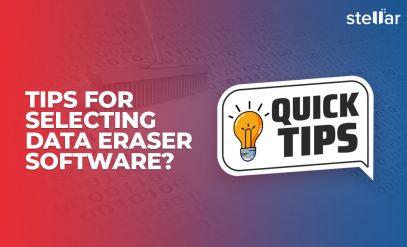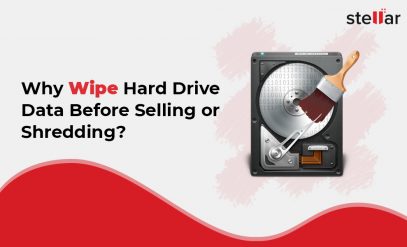| Summary: Data erasure is taken very seriously in the healthcare industry. However, the only reliable way to erase data on an enterprise level is to use dedicated software like BitRaser and avoid Healthcare Data Breach. This ensures not just security and peace of mind, but also compliance with international data erasure regulations across the globe. |
|---|
Healthcare is a heavily regulated industry.
The government sets laws affecting – among other aspects – healthcare cyber security.
These laws revolve around things like:
- Patient Data Privacy
- Doctor-Patient Confidentiality
- Maintenance of Privacy In Records
As such, several challenges are faced in healthcare cyber security. In this article, we will explore these challenges.
Table Of Contents
Through the course of this article, you will learn the following things:
- Data deletion v/s data erasure: The difference
- Key healthcare cyber security challenges
- Key considerations related to healthcare cyber security
- Data erasure solutions in healthcare cyber security
- Things to remember
Data Deletion V/s Data Erasure: The Difference
“Data deletion” and “data erasure” may sound similar, but they have very different implications. To cut a very long story short: Data deletion frees up space on the system by marking locations as “available to write”.
Data erasure is the process of removing data completely from a device. It does this by first deleting, and then overwriting the deleted data with binaries (zeroes and ones).
Here is a high-level overview of the differences between data deletion and data erasure:
| Point Of Distinction | Data Deletion | Data Erasure |
|---|---|---|
| Space Freed Up On The System | Yes | Yes |
| Data Is Still Easily Accessible | Yes | No, In No Cases |
| Complies With Regional Legal Regulations | No | Yes |
| Provides A Degree Of Security | No, Absolutely Not | Yes, Very Secure |
| Has Standardized, Enterprise Level Solutions | Not Applicable | Yes, Hundreds. |
In this context, there is one very important thing that you need to understand. This is explained further in the next section.
Key healthcare cyber security challenges
Let us look at some of the key cybersecurity challenges faced in the healthcare Industry.
1. Legal And Regulatory Compliance: Companies in the healthcare domain need to ensure that they comply with legal guidelines. Many countries and regions around the world have regulations about data erasure in healthcare.
Non-compliance almost always attracts legal action and stupendous fines. A prime example would be HIPAA in the United States of America. HIPAA stands for “Health Insurance Portability and Accountability Act”. It is solely concerned with data protection and proper data erasure to “maintain patient privacy”.
There are similar laws in place all around the world. Some of the most prominent are:
- GDPR – General Data Protection Regulation – The European Union
- PHIPA – Personal Health Information Protection Act – Canada
- HCCA – Health Care Consent Act – Canada
- PDPA – Personal Data Protection Act – Singapore
- NHS DDSCPT – Digital’s Data Security and Protection Toolkit – United Kingdom
- HITRUST CSF – Health Information Trust Alliance Common Security Framework – An unofficial, Globally adopted framework.
Summary: These are just some examples, there are a whole lot more. These regulations pose the most significant challenge to the healthcare industry. At the same time, these healthcare data protection(s) reassure people that their privacy is maintained.
2. The Sensitive Nature Of Patient Data: The medical data of a patient is some of the most sensitive kinds of information about a person that is logged. It contains treatment records, medical histories, personal identifiers, financial records, and a whole lot more.
Apart from the privacy aspect, a lot of this data could be misused. That is why the scrutiny placed on the healthcare industry is not only needed but welcome.
Summary: Think about it. If the data was not protected the way it currently is, it could influence the employment of a person, insurance premiums, loans, mortgages, and a whole lot more.
3. Diverse Data Storage Systems: Many people come together to make the modern healthcare apparatus work. Healthcare data protection across device types, generations, and manufacturers is a herculean task.
However, the system is far from perfect. Not everyone uses the same file types. Not everyone has access to or uses the same devices. Even among those that do have similar devices, not everyone uses the same file storage system. Consider this: A particular clinic uses iPads as their main device.
The receptionist uses a Windows PC, connected to a Linux/Apache Server. The clinic needs to share records with a hospital that only uses legacy devices from the mid-2010’s. This does not even touch on the topic of imaging data deletion. That is a whole other headache to deal with, which we may cover in a separate article.
Summary: Different healthcare providers store their patient data differently. This is a major hurdle in the healthcare industry.
4. Lifecycle Of Medical Devices: Diamonds are forever, but medical devices are most certainly not. Various devices are used in the healthcare industry, from tablets and computers to complex medical equipment. A ton of data is stored on these devices.
The main healthcare data security problem? Different medical devices have different life cycles. At the end of these life cycles when the devices are repurposed or destroyed, it is important to follow proper methods of data erasure. This is to ensure that no residual data remains on these devices, which, for obvious reasons, would be disastrous.
At such a stage, simply “formatting” a device would not cut it. You need to perform a full data wipe. Depending on the nature of the device, you would probably want to degauss the memory too.
Summary: Even though the devices that are used in the healthcare/ medicare sector are very likely to be industrial-grade, they will eventually begin to age.
5. Third-Party Involvement: More often than not, healthcare providers outsource their needs. This includes their data storage needs. When changing vendors, closing shop, or if the vendor shuts down, problems arise.
This can create many challenges if the vendor does not follow proper protocol for medical patient record data erasure. All this goes to say that data privacy in healthcare is quite a complex puzzle to figure out.
Summary: Ensuring that the patient records are securely deleted from their old vendor is the responsibility of the healthcare provider, not the vendor.
6. Data Fragmentation And Redundancy: Put simply, data fragmentation is when data is split into several parts and stored in different locations.
If patient data and records are fragmented, then it becomes harder to erase them. However, data fragmentation in the healthcare industry is next to unavoidable. This is a major challenge for those who work in the healthcare sector.
Summary: Having a centralized database is quite impossible, so data fragmentation occurs regularly.
7. Data Retention Policies: Healthcare providers need to toe a very fine line. The line between the retaining of data for clinic purposes, and between compliance with data deletion regulations.
That said, a major caveat exists. Certain procedures (transplants, plastic surgery, etc) need to be kept on record forever for legal reasons. All these challenges need to be taken into consideration when planning healthcare data security.
Summary: Clear data retention policies and implemented practices need to be implemented to avoid problems down the line.
8. Staff Training And Awareness: As always, the weakest link in this chain is — the people. Computers are infallible, but humans are certainly not. Healthcare providers also need training in how to avoid a potential healthcare data breach.
A lot of healthcare providers are targeted via phishing and scam attacks all the time. Proper training would go a long way to alleviate this risk. However, it is important to remember that healthcare professionals already have a lot of training to do and other things to learn.
Summary: Data security training would fall very low on a healthcare professional’s list. However, it is a consideration to keep in mind.
9. Emerging Technologies: As new technologies hit the market, new healthcare data breach risks rear their heads. For example, before the digital era, all paper patient records could be secured in a locked room.
Similarly, the advances in technologies also come with advances in exploiting those new technologies. Things like the introduction of cloud storage and the IoT (Internet of Things) have come to life. These bring in complications that have never been seen or dealt with before.
Summary: As new technologies are introduced into the healthcare industry, new challenges will have to be overcome concerning healthcare cyber security.
10. Data Ownership And Access Control: The last major challenge in the healthcare industry is data ownership and proper access control. The problem? Healthcare data often has many stakeholders.
To give you an idea of who would have access to a single patient’s data, look at this list.
The people with access would include:
- The Patients,
- The Doctors,
- The Nurses,
- The Orderlies,
- The Pharmacists,
- The Insurance Companies,
- The State,
- The Governments, And
others as regionally applicable.
With so many people having access to and control over healthcare patient records, proper data erasure becomes a challenge. Especially given the fact that, in all likelihood, each of these stakeholders probably has a copy and a backup of the data.
Key considerations of healthcare cyber security
Although unrelated to data erasure, here are some factors that influence data erasure processes in the healthcare industry.
- Data Migration And Disposal: Like you learned earlier, when migrating from an old system to a new one, or from one service provider to another, data erasure is key. Healthcare providers need to ensure compliance with regulations and that the old data is destroyed and inaccessible.
- EHR And Legacy Systems: EHR stands for “Electronic Health Records”. Often, old EHR systems become out of date when they get old. When they are replaced, the old system is called the “legacy system” and the new one the “current system”. Data erasure on legacy EHR systems can pose a problem, depending on the type of storage used.
- Cloud Data Storage: It is very hard to get rid of data on the cloud. Healthcare providers often use enterprise versions of cloud storage. These services are specifically designed to make data secure and virtually undeletable. If a healthcare provider wants something deleted, the process on a cloud platform is usually very long drawn out.
- Data Erasure Verification: You have complied with data erasure norms. You complied with data erasure regulations. You did everything by the book. But, you have no proof that you did so. That is why you need to ensure that any data erasure solution that you deploy generates reports proving the destruction of the data. BitRaser auto-generates these reports for you for every single piece of hardware that you wipe using BitRaser.
- Incident Response Planning: In the event of a healthcare data breach, proper action plans need to be prepared and ready to go.
This is the responsibility of the healthcare provider, who is liable for damages faced in the event of a healthcare data breach.
Data Erasure Solutions In the Healthcare Industry
Though a lot of these challenges may seem insurmountable, that couldn’t be further from the truth. So then, what is the best way to overcome these challenges and take into account these considerations? The answer already exists. Purpose-built software, such as BitRaser is there to do the job for you. BitRaser is not just some drive formatting tool It is a 360-degree data erasure solution.
Does it wipe your drive to the standards required by governments around the world? Yes.
Does it provide a detailed report of the wipe of each drive after it finishes? Yes.
Is it a complete, all-in-one tool that can help you comply with international regulations? Yes.
Also, reports generated by BitRaser comply with requirements for audit trails, which is something that not a lot of data erasure solutions provide.
Bitraser already complies with data erasure standards set by the DOD, NIST, and others. It complies with standards set by governments around the world, including the USA, UK, Canada, New Zealand, Australia, Switzerland, and a whole lot more.
BitRaser complies with no less than 24 international data erasure standards. It works on pretty much any digital device that can read USB sticks and can delete any kind of data. With competitive pricing and a global customer base, it is the ideal option for data erasure needs in the healthcare industry.
Things To Remember
In essence, the patient retains the “right to be deleted”. Of course, this right too, has exceptions, but that is a topic for a future post. That said, there has been growing concern over the increasing number of healthcare data breaches.
For instance, of all data breaches reported in 2022, 20% of the attacks targeted healthcare firms.
This officially makes the healthcare industry the foremost target of all data breaches, ahead of the public sectors (16%) and even IT sectors (11%). That is why healthcare cyber security is taken so seriously because healthcare data breaches can have far-reaching implications.
Luckily, standardization has been in place for a very long time and is considerably successful in keeping patient data safe. Provided that proper data erasure practices have been followed —that is.







